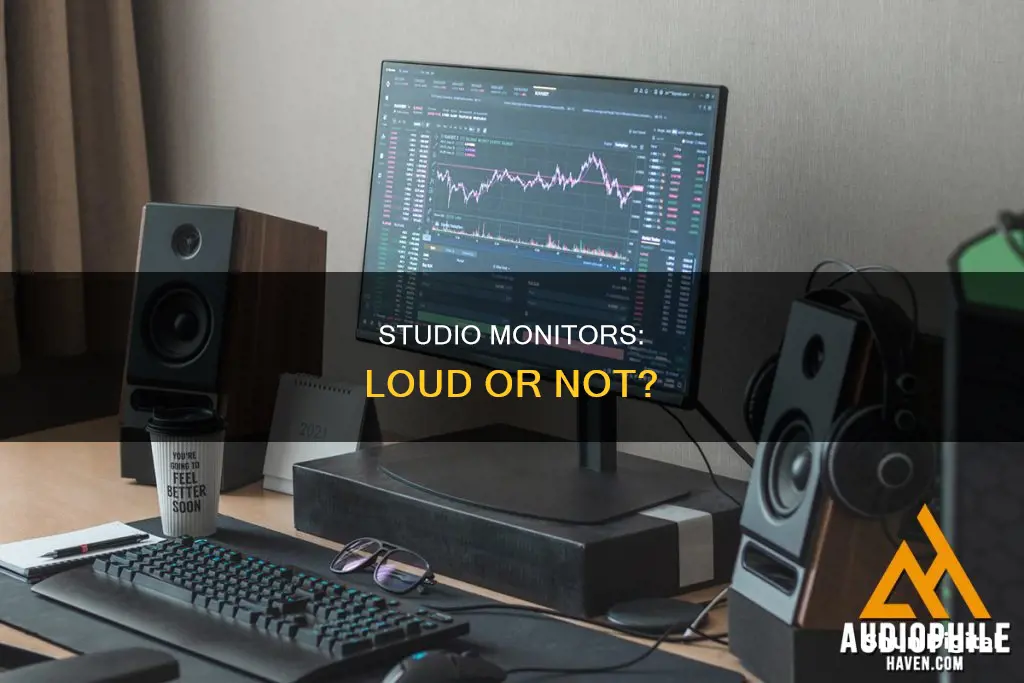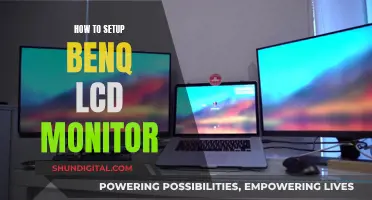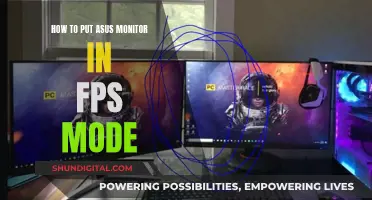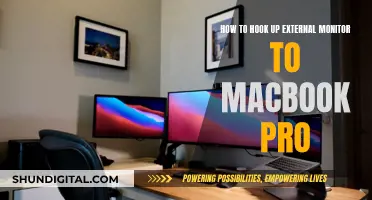
Studio monitors are a type of speaker designed to help listeners discover every detail of sound. They are commonly used for recording and listening to music. The loudness of studio monitors depends on various factors, including the size of the room, the distance from the speakers, and the quality of the components. While some studio monitors can produce extremely loud volumes, it is important to consider hearing protection and safe listening levels to prevent hearing damage.
What You'll Learn

Studio monitors for small studios
Studio monitors are designed to deliver a flat frequency response, ensuring that what you hear being played is the actual mix in all its glory. Studio monitors are loud enough to fill small to medium-sized rooms adequately. The bigger the monitor, the more power it can output, and the more bass frequencies you can expect.
If you're looking for studio monitors for a small studio, there are several options to consider. Here are some recommendations and features to help you choose the right ones for your needs:
Yamaha HS5
The Yamaha HS5 is one of the most popular choices for studio monitors and is perfect for mixing duties due to its honest sound reproduction. It has a frequency response of 54 Hz – 30 kHz and a 2-way speaker configuration with a 5” woofer and a 1” Kevlar tweeter. These monitors deliver ultra-clarity and transparency, ensuring you can identify any issues in your mix. They are incredible value for money and are ideal for those who want to mix and produce music.
KRK Rokit
The KRK Rokit is a popular choice for electronic music production and is known for its distinctive yellow cones. It falls into the nearfield monitor category and is ideal for smaller home studio setups. The KRK Rokit features a graphic EQ function on the speaker, allowing you to adjust the sound to your studio space. It also includes digital signal processing (DSP) tools, such as a room analyser, to compensate for any dead zones or sonic blind spots in your room.
JBL 305P MKII
The JBL 305P MKII is an excellent choice for beginners looking for their first set of studio monitors. They deliver articulate sound, making them perfect for mixing your own music. These monitors offer a wide sweet spot, balanced sound, and EQ controls, allowing you to adjust the sound to your setup. They are also fantastic value for money, making them a great option for small studios.
IK Multimedia iLoud MTM
If you're short on space, the IK Multimedia iLoud MTM offers a balance between size, audio quality, and affordability. These monitors are compact enough to fit in any setup, no matter how small. They are clinically honest and deliver exceptional imaging and separation, making it easy to target individual elements within your mix. The iLoud MTM is a great choice for those with limited desk space or seeking a secondary pair of surgical monitors.
M-Audio BX4
The M-Audio BX4 is a budget-friendly option, offering a pair of monitors at a price lower than most individual monitors from other manufacturers. They feature 4.5” Kevlar LF drivers and a 1” silk dome tweeter, providing a good bass response and precise high-end frequencies. These monitors are simple to set up, look great, and deliver a phenomenal sound, making them perfect for beginner producers or those on a budget.
When choosing studio monitors for a small studio, consider factors such as size, power, frequency response, connectivity options, and your specific needs, such as mixing, producing, or simply enjoying music. Remember that the right studio monitors will reveal everything about your music and provide an honest representation of your recordings.
Rick Ross' Ankle Monitor: A Legal Conundrum
You may want to see also

Studio monitors for home studios
Studio monitors are an essential component of any home studio setup, providing accurate sound reproduction for mixing and mastering tracks. When choosing studio monitors for your home studio, there are several factors to consider to ensure you get the best sound quality and features for your needs.
Firstly, it's important to decide on your budget. Studio monitors can range from very affordable options like the M-Audio BX4s and BX5s to high-end models such as the Focal Shape series. Your budget will determine the features, sound quality, and overall performance you can expect from your studio monitors.
The size of your studio monitors is also an important consideration. If you have a small home studio, opt for compact monitors like the IK Multimedia iLoud MTM or the Kali Audio LP-6s, which offer excellent sound quality without taking up too much space. On the other hand, if you have a larger studio space, you might want to consider larger monitors with bigger woofer sizes, like the Quested 3208, to fill the room with sound.
Another key factor is the type of music you'll be producing. For electronic music and bass-heavy genres, monitors with a strong low-end response, like the KRK Rokit series, are ideal. If you're mixing rock or other non-electronic music, you might prefer monitors with a more balanced frequency response, such as the Yamaha HS5s, which are known for their honest sound reproduction.
Additionally, pay attention to the connectivity options offered by different studio monitors. Most active monitors will have jack, XLR, phono, digital, and/or USB connections, allowing you to connect directly to your audio interface or computer. If you opt for passive monitors, you'll need a separate amplifier, so keep that in mind when making your choice.
Lastly, consider the specific features offered by different studio monitors. Some monitors, like the KRK Rokit G4 series, include graphic EQ functions built into the speaker, allowing you to fine-tune the sound to your studio space. Others, like the IK Multimedia iLoud MTM, offer room calibration systems to ensure optimal sound in any room.
Remember, the most important aspect of studio monitors is their ability to provide accurate sound reproduction so that you can make informed decisions during the mixing and mastering process. Choose the monitors that best fit your budget, studio size, music style, and personal preferences to ensure you get the most out of your home studio setup.
Removing Matte Coating: Monitor Restoration Guide
You may want to see also

Studio monitors for beginners
Studio monitors are an essential component of any recording setup, allowing you to hear your music in intricate detail and make informed decisions when mixing and applying EQ, compression, and other audio techniques. When choosing studio monitors, you'll be faced with a wide range of options, from different types of speakers to various features and price points. This guide will help beginners navigate the world of studio monitors and make informed choices when building their recording setup.
Types of Studio Monitors
Studio monitors can be broadly categorized into two types: active and passive. Active monitors have built-in amplifiers, while passive monitors require separate external amplifiers. Active monitors are more common and convenient, as they can be directly connected to your audio interface or computer. Passive monitors, on the other hand, are typically used in professional studio settings and offer more flexibility in amplifier choice.
Factors to Consider
When choosing studio monitors, there are several factors to consider:
- Size: Bigger monitors generally output more power and deliver more bass. Choose monitors that fit your room size; larger monitors can overload a small space.
- Frequency Response: Look for monitors with a wide frequency response range, covering both high and low frequencies. This ensures you can hear all the details in your mix.
- Speaker Configuration: Most studio monitors use a two-way design with a woofer for low frequencies and a tweeter for high and mid-high frequencies. More expensive monitors may feature three-way or four-way designs for clearer midrange frequencies.
- Connectivity: Active monitors typically offer various connection options, including jack, XLR, phono, digital, and USB. If using passive monitors, ensure your external amplifier is compatible with your audio interface or computer.
- Price: Studio monitors vary widely in price, from budget-friendly options to high-end models. As a beginner, you can find excellent monitors at affordable prices.
Recommended Studio Monitors for Beginners
- JBL 305P MkII: These monitors offer fantastic value, delivering articulate sound perfect for beginners learning to mix their music. They have a wide sweet spot and a balanced frequency response, making them great for long listening sessions.
- M-Audio BX4: This pair of monitors is more affordable than most individual monitors, making them ideal for budget-conscious beginners. They offer surprisingly good bass response and precise high-end frequencies.
- Yamaha HS5: The Yamaha HS5s are popular among beginners due to their honest sound reproduction. They provide incredible value for money and are perfect for those interested in mixing and producing music.
- IK Multimedia iLoud MTM: These compact monitors are perfect for small spaces and offer a balance of size, audio quality, and affordability. They include room calibration to ensure optimal sound in your mixing space.
- KRK Rokit: The KRK Rokit series is a popular choice for electronic music production, featuring distinctive yellow speaker cones. They offer a range of features, including graphic EQ and room analyser tools, making them ideal for smaller home studios.
Air Quality Monitors: Choosing the Right Manhole Testing Device
You may want to see also

Studio monitors for electronic music production
Studio monitors are an essential component of the music production process, allowing producers to hear their tracks in intricate detail and make informed decisions when applying EQ, compression, and other sound manipulation techniques. When choosing studio monitors for electronic music production, there are several factors to consider, including size, features, sound quality, and budget.
One of the most popular choices for electronic music production is the KRK Rokit series, known for their distinctive yellow cones. The Rokit 5 G3/G4 model is used by many renowned DJs and producers, including Steve Aoki, Skrillex, and Paul Van Dyk. These monitors offer a characteristic and even response, making them well-suited for electronic dance music. The latest generation, the 5" KRK ROKIT RP5 G4, features DSP-driven Graphic EQ and matching Kevlar drivers, providing sonic honesty across all frequencies. At approximately $179 per piece, they are an affordable option for those on a budget.
Another option to consider is the Yamaha HS5, which offers ultra-clarity and transparency, allowing producers to identify any issues in their mix. With a frequency response of 54 Hz – 30 kHz, these monitors deliver an honest representation of your recordings. While they may not provide the same bass response as larger monitors, they are excellent for mixing and mastering due to their accurate sound reproduction. The Yamaha HS5 series is available for $529.
If you're looking for a high-end option with pro levels of balance and clarity, the Focal ST6 Twin6 is an excellent choice. These monitors deliver a breathtaking soundstage and wide stereo image, constructed with the best materials and robust build quality. However, they are relatively large and loud, making them unsuitable for small or untreated home studios.
For those with a limited budget, the Adam Audio T5V is a fantastic option, offering precise top-end frequencies ideal for mixing. These monitors feature a 5-inch woofer and Adam's U-ART tweeter, delivering a broad horizontal sweet spot and excellent imaging and separation. While the low mid-range frequencies could be improved, this can be addressed by adjusting the LF EQ.
When choosing studio monitors, it's essential to consider the size of your room and the placement of the monitors. Nearfield monitors are designed for smaller spaces and should be placed close to the listener's ears, while midfield monitors require a larger room and should be positioned at a greater distance. Additionally, the size of the monitors and their bass response capabilities should be considered based on the room's acoustics and treatment.
Wifi Adapter Monitor Mode: How to Check?
You may want to see also

Studio monitors for guitar amp modelling
Studio monitors are designed to reproduce audio with a high degree of accuracy and clarity. They are specifically engineered for use in recording studios and music production. Studio monitors are speakers that deliver a flat frequency response, meaning they reproduce sound as accurately as possible without any added enhancements. This makes them an important tool for musicians, sound engineers, and producers to hear every detail of a recording with precision.
When it comes to guitar amp modelling, studio monitors can be a great asset. They will enable you to accurately hear the tones of your guitar when using amp modelling software. This will allow you to make precise adjustments to your tone and ensure that your guitar sounds the way you want it to.
There are a few things to consider when choosing studio monitors for guitar amp modelling:
- Size and Type: Studio monitors come in different sizes, including near-field, mid-field, and far-field monitors. Near-field monitors are small-sized and designed for use in home studios or small spaces. Mid-field monitors are larger and meant for medium-sized spaces, while far-field monitors are the largest and used in concert venues or large recording studios. You should choose a size that is appropriate for your space. Additionally, you will need to decide between active and passive monitors. Active monitors have built-in amplifiers, while passive monitors require an external amplifier. Active monitors are generally more convenient and offer greater control over sound output, making them a popular choice.
- Sound Quality: The quality of the studio monitors will directly impact the accuracy, detail, and clarity of the sound. Look for monitors with a flat frequency response to ensure accurate sound reproduction. The frequency range and frequency response are important factors to consider, as they will determine the range of frequencies the monitor can reproduce accurately.
- Budget: Studio monitors can vary widely in price, so it's important to consider your budget. While cheaper options may be tempting, investing in higher-quality monitors may save you money in the long run by providing greater durability and accuracy. Don't forget to include the cost of any necessary accessories, such as cables, stands, and acoustic treatment for your room, in your budget.
- Yamaha HS5: Renowned for its accuracy and flat frequency response, making it a great choice for guitarists. Features a 5-inch woofer and a 1-inch tweeter, delivering a frequency response range of 54 Hz to 30000 Hz. Offers room control and high-trim response controls to adjust the sound to your listening environment. Price per pair: ~$400.
- KRK Rokit 5: Delivers high-quality sound at a budget-friendly price. Equipped with a 5-inch woofer and a 1-inch tweeter, providing a frequency response range of 43 Hz to 40,000 Hz. Built-in Class D amplifier delivers up to 55 watts of power. Includes integrated digital signal processing (DSP) features and a graphic EQ controlled by an LCD screen. Price per pair: ~$380.
- Behringer Truth 2030A: Detailed sound with good balance across spectrums. Features a 6.75-inch woofer. A cheap and good set of speakers, but there is a design lawsuit from Genelec for copying their design. Price per pair: $300.
- JBL LSR308: Fun and pleasing sound with plenty of bottom end. Inherits design features from its more expensive cousins. The uniquely designed tweeter flare provides a wider soundstage and silky highs. Low frequencies can sometimes be overpowering. Price per pair: $250.
- M-Audio AV40: Provides enough power at low levels and a good representation of the guitar sound. Offers a good mid-range with proper high mids and a bit more low end than the Yamaha HS5. A personal favourite for the reviewer, providing a "what you hear, is what you get" guitar sound. Price per pair: $280 (used).
When choosing studio monitors for guitar amp modelling, it's important to trust your ears and consider your specific needs and requirements. The options listed above offer a range of features and price points to suit different budgets and listening environments.
Ankle Monitor SCRAM: How Does It Work?
You may want to see also
Frequently asked questions
It depends on how close you are to the speakers and the size of the room. If you start to hear distortion, you should reduce the volume as something is running past its limit.
Studio monitors are designed to produce an honest and flat frequency response, so they are not designed to be louder than other speakers. However, some studio monitors can get very loud, especially when paired with a separate amplifier.
Bigger woofers generally mean more power and more bass frequencies. However, the overall loudness of the studio monitor depends on various factors such as amplification, speaker layout, and room size.
Yes, studio monitors with a separate amplifier can be louder than active monitors with a built-in amplifier. The separate amplifier provides more power, resulting in higher volume levels.
Yes, some studio monitors are known for their ability to produce high volume levels. Examples include the Quested 3208, JBL LSR28s, ADAM S3X-V, and Dunaudio AIR 15.







